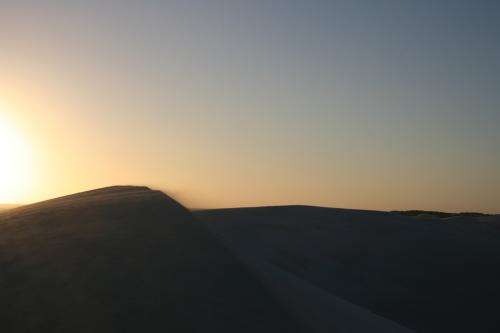Travelling dunes encroach on infrastructure, and reveal geological pattern

Recent research shows shifting sand dunes threaten to envelop several important Mid West roads within the next few years.
German post-graduate intern Josefine Bruch came to this conclusion after comparing old aerial photographs and Google Earth images of sand dunes near the coast between Lancelin and Geraldton.
She studied images of 15 dunes taken between 1960 and 2010, and found them to have travelled at speeds of between 4.1 and 22.8m per year.
Her report says two of the dunes, at locations near Dongara west and Grey, are due to encroach on existing infrastructure "now".
Her supervisor, Department of Mines and Petroleum geologist Mike Freeman, says the crescent shaped dunes originate from beach sand.
"We have very little erosion off the hinterland," he says.
"There's no sands and mud getting dragged down by rivers and getting dumped in the ocean so what builds up on the beaches is effectively just beach sands.
"They are either from remobilisation of existing sediments, ie the Perth Basin sediments under the beaches, or it's from sea shells.
These are washed onto the beach where they are pounded into sand particles which gradually accumulate as parallel rows of sand dunes.
Mr Freeman says crescent dunes originally form as prevailing winds erode these parallel sand dunes unevenly.
"Once it becomes separated from the beach it doesn't get any more supply of sand," he says.
"So it will keep on moving until it progressively becomes stabilised.
"Some of these dunes, they move many kilometres from the beach."
He says vegetation eventually stabilises them.
"So it's an interesting perspective of how the geological evolution of the hinterland has controlled the formation of the sands on the beaches that can form the dunes which then go inland and become stabilised to become limestone again," he says.
In the meantime, Mr Freeman says several local councils may be faced with the cost of either removing encroaching active dunes, or relocating roads and other infrastructure, within the next few years.
If they take the first option, the alkaline sands could be used to treat wheatbelt paddocks plagued by increasing soil acidity.
Mr Freeman says farmers as far east as Merredin have reported good results after adding beach sands to their soils, but transports costs are high.
Another option would be to try stabilising encroaching dunes with introduced vegetation, an unacceptable practice if dunes lie within nature reserves.
Provided by Science Network WA




















